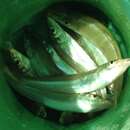Diagnostic Description
provided by Fishbase
This species is distinguished from its congeners by the following set of characters: swimbladder divided posteriorly into 2 tapering extensions projecting below the vertebral column extending into the tail musculature; no scales on the preoperculum and on most of the operculum; 34 total number of vertebrae; swimbladder with lateral extensions each spreading a blind tubule anterolaterally; nostrils at the level of the upper quarter of the orbit with anterior nostril having a small flap and nearly round posterior nostril situated close to the first (Ref. 94953)..
- Recorder
- Estelita Emily Capuli
Morphology
provided by Fishbase
Dorsal spines (total): 11 - 13; Dorsal soft rays (total): 19 - 22; Analspines: 2; Analsoft rays: 18 - 22; Vertebrae: 34
- Recorder
- Estelita Emily Capuli
Trophic Strategy
provided by Fishbase
Usually on sandy substrates, where juveniles and subadults (up to 1.20 cm TL) are very common in shallow water of sandy beaches. Reported (Ref. 69752) to feed on benthic invertebrates, mainly on polychaetes and, to a lesser extent, on crustaceans (Refs. 94953, 127989). Dwells in benthic sandy substrates (Ref. 127989).
- Recorder
- Estelita Emily Capuli
Biology
provided by Fishbase
Usually on sandy substrates, where juveniles and subadults (up to 1.20 cm TL) are very common in shallow water of sandy beaches. Reported (Ref. 69752) to feed on benthic invertebrates, mainly on polychaetes and, to a lesser extent, on crustaceans. Known spawning season is from April to September. A commercial species in Israel caught by trawl and trammel net (Ref. 94953).
- Recorder
- Estelita Emily Capuli
Sillago suezensis
provided by wikipedia EN
Sillago suezensis is a species of marine fish in the smelt-whiting family Sillaginidae. It is found in western Indian Ocean and in the northern Red Sea including the Gulf of Suez. Following its first record in the Mediterranean Sea, off Lebanon in 1977,[1] it experienced a population explosion in Levantine waters where it is now very common and reaches to the Aegean Sea.[2] This species reaches a length of 18.5 cm (7.3 in).[3]
References

- license
- cc-by-sa-3.0
- copyright
- Wikipedia authors and editors
Sillago suezensis: Brief Summary
provided by wikipedia EN
Sillago suezensis is a species of marine fish in the smelt-whiting family Sillaginidae. It is found in western Indian Ocean and in the northern Red Sea including the Gulf of Suez. Following its first record in the Mediterranean Sea, off Lebanon in 1977, it experienced a population explosion in Levantine waters where it is now very common and reaches to the Aegean Sea. This species reaches a length of 18.5 cm (7.3 in).
- license
- cc-by-sa-3.0
- copyright
- Wikipedia authors and editors

